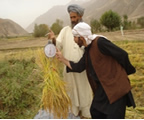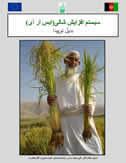Featured Items
January 30, 2012
AFGHANISTAN: SRI Continues to Increase Yields in Two Provinces
-
According to the Aga Khan Foundation - Afghanistan (AKF-A) SRI final report for 2011, 114 farmers, including seven resource persons (RP) and twenty new volunteers, have been applying SRI methods for rice cultivation in two districts of Baghlan and Takhar provinces, as part of the Participatory Management of Irrigation Systems (PMIS) project, managed by AKF. The project is part of the larger government-led Panj-Amu River Basin Program (PARBP), which is funded by the European Union. A field day and exposure visits between the two areas provided opportunities for the farmers to discuss their successes and problems with one another.
 In both districts (Doshi
in Baghlan Province and Taloqan in Takhar Province), the average results
clearly show a net improvement in SRI yield compared to the yield with the
traditional (10.01 t/ha with SRI vs. 5.04 t/ha with traditional methods -- an
average combined yield increase of + 49.65% for both districts.)
In both districts (Doshi
in Baghlan Province and Taloqan in Takhar Province), the average results
clearly show a net improvement in SRI yield compared to the yield with the
traditional (10.01 t/ha with SRI vs. 5.04 t/ha with traditional methods -- an
average combined yield increase of + 49.65% for both districts.) -
The SRI yield of the first crop (single) was found to be higher than transplanting with SRI methods as second crop. Analysis of the data revealed that the key factors contributing to higher yield were (in order of importance), 1) the 47% increase in the number of grains per panicles, 2) the 22% increase in tillers per m2 and 3) a 2% average increase in weight per grain. A Directorate of Agriculture, Irrigation and Livestock staff member and farmer RP are shown at right taking measurements for the yield analyses. Detailed data and methodology are provided in the 2011 report as are the recommandations for the 2012 SRI campaign.
 Shown at right is the Dari
language SRI manual (سيستم
افزايش
شالی(ايس آر
آی) - بديل
نوپيدا) prepared by the PMIS project that
has been available for several years to help farmers with SRI trials (see also
English
version).
Shown at right is the Dari
language SRI manual (سيستم
افزايش
شالی(ايس آر
آی) - بديل
نوپيدا) prepared by the PMIS project that
has been available for several years to help farmers with SRI trials (see also
English
version). -
At left is a slide show by Ali Mohammad Ramzi on AKF's work in Afghanistan over the past few years.
Although several efforts were made by CIIFAD as early as 2003 to get SRI methods evaluated in Mazar-e-Sharif and Ajrestan (see report), there was no evident SRI uptake in Afghanistan, the first real progress we know of began when the Aga Khan Foundation began working with the methods in a systematic way in 2007. German Agro Action (GAA) also began SRI trials 2007, and while the trials were not completely successful, they continued with SRI projects until security problems caused GAA to withdraw. AKF trials in 2009 were successful, as were trials and outreach efforts in 2010 and 2011. During 2010, the total number of participating farmers in three districts of Baghlan and Takhar provinces was 150% higher than in the 2009 program, despite having to withdraw (due to security issues) from activities in Baghlan district of Baghlan province, which was the main project area during 2009.
-
For more information, including project documents, PowerPoints and extension information, see our Afghanistan page.
January 20, 2012
CHINA: Agricultural Water Savings with Modified
SRI Practices in Sichuan
-
SRI has become Sichuan Province's preferred rice production method since 2005, with reports of the provincial yield record for rice being broken year after year. By 2010, the SRI area in Sichuan Province had reached over 301,067 ha, starting from 1,133 ha in 2004. SRI methods are currently used in 123 of its 130 rice-growing counties. According to researchers at the Sichuan Academy of Agricultural Sciences, the average SRI yield has been 9.5 t/ha, representing an average increase of 1.8 t/ha over conventional rice cultivation in the province. The value of additional paddy yield per hectare using SRI methods in 2010 was worth USD 185 at current exchange rates, achieved with lower costs of production. For Sichuan province as a whole, the value of the additional paddy produced was over USD 100 million. For the period 2004-10, the total additional benefit of using SRI methods in Sichuan was almost USD 320 million at the current rate of exchange, accompanied by reduced costs and less requirement of water.
Agriculture consumes 80% of the total water resources in Sichuan Province, which has a population of 88.6 million. A recent article by Zheng Jia-guo and his colleagues the the Crop Research Institute, SAAS, Chengdu, details how they are adapting SRI to conserve water in that province as well as how this may change in the future. With modified SRI practices, both WUE (Water Use Efficiency) and IWUE (Irrigation Water Use Efficiency) were shown to be higher than with the traditional practices, by 54.2% and 90.0%, respectively, significantly reducing water consumption.
In addition to reducing irrigation water by 25.6% and seed requirements by 50-90%, the modified SRI practiced in Sichuan has shown a number of other benefits, such as increased leaf area index (LAI), larger plants, and fewer insect and disease problems. Over the years, SRI methods in Sichuan have been adapted in several ways: 1) a triangular planting pattern (15-18 plants/m2), which is more effective with the lower solar radiation in that area of China, 2) a combination of mulching and herbicides that replaces hand and mechanical weeding (due to labor considerations), 3) slightly older seedlings (greater than the usual 2-leaf stage) that fit better into the seasonal planting pattern and 4) inorganic fertilizers mixed organic fertilizers due to low availability of biomass. The mulching also assists in water retention, making fields more drought-resistant. The changing structure of the rural labor force may lead to additional changes in the future, particularly with regards to mechanization [..more].
For more information on SRI in China, see our SRI China page.

